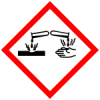Coalition status
Fairtrade Red
This list contains 207 pesticides. The list is valid as of January 2018.
Prohibited pesticides that must not be used on Fairtrade products under any…
FSC restricted HHPsChemical pesticide presenting one out of three of the following hazards: acute toxicity, chronic toxicity and environmental toxicity.
GCP-Phase-Out 2026Use of pesticides in the Phase-out List are reduced through use of Integrated Pest Management and phased out by 2030, if feasible. This includes…
SAN Risk MitigationThe SAN List of Pesticides for Use with Risk Mitigation is a product of U.S.A. public funding and the intellectual property of the analysis process…
UEBT Risk MitigationThe use of the Risk Mitigation Agrochemicals is discouraged as they are known to bear significant human health and environmental risks. Where these…
UTZ WatchlistUTZ Watchlist is composed of active ingredients that are not banned but that have a potentially severe and/or cumulative risk for human health and/or…
Details
Type: Pesticide
Use: Herbicide, Fungicide, Nematicide, Insecticide
Example applications: Vegetables;Fruit;Ornamentals;Fiber crops;Cover crops
Example pests controlled: Weed and disease suppression including control of annual bluegrass, chickweed, ragweed, nutgrass, morning glory;Sclerotina, club root and Rhizoctonia;Damping off;Some nematodes
Mode of action: Soil fumigant, binds to oxygen carrying molecules and prevents tissues from using oxygen. Multi-site activity.
Source: PPDB
Toxicty
EPA: Probable Human Carcinogen
Agents with sufficient evidence (i.e., indicative of a causal relationship) from animal bioassay data, but either limited human evidence (i.e.,…
GHS safety labels
About Globally Harmonized System of Classification and Labelling of Chemicals (GHS)
From Wikipedia: The Globally Harmonized System of Classification and Labelling of Chemicals (GHS) is an internationally agreed-upon standard managed by the United Nations that was set up to replace the assortment of hazardous material classification and labelling schemes previously used around the world. Core elements of the GHS include standardized hazard testing criteria, universal warning pictograms, and harmonized safety data sheets which provide users of dangerous goods with a host of information. The system acts as a complement to the UN Numbered system of regulated hazardous material transport. Implementation is managed through the UN Secretariat. Although adoption has taken time, as of 2017, the system has been enacted to significant extents in most major countries of the world.[1] This includes the European Union, which has implemented the United Nations' GHS into EU law as the CLP Regulation, and United States Occupational Safety and Health Administration standards.
- H302

Harmful if swallowed
Class: Acute Toxicity
Subclass: Oral - H314

Causes severe skin burns and eye damage
Class: Corrosion/irritation
Subclass: Skin - H317

May cause an allergic skin reaction
Class: Sensitization
Subclass: Skin - H400

Very toxic to aquatic life
Class: Aquatic
Subclass: Acute - H410

Very toxic to aquatic life with long lasting effects
Class: Aquatic
Subclass: Chronic
